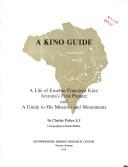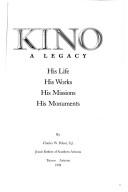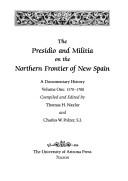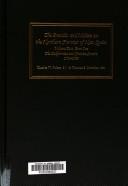| Listing 1 - 10 of 12 | << page >> |
Sort by
|
Book
ISBN: 0816504881 9780816504886 Year: 1976 Publisher: Tucson (Ariz.): University of Arizona press,
Abstract | Keywords | Export | Availability | Bookmark
 Loading...
Loading...Choose an application
- Reference Manager
- EndNote
- RefWorks (Direct export to RefWorks)

ISBN: 0915076047 Year: 1976 Publisher: Tucson, Arizona Southwestern Mission Research Center
Abstract | Keywords | Export | Availability | Bookmark
 Loading...
Loading...Choose an application
- Reference Manager
- EndNote
- RefWorks (Direct export to RefWorks)

ISBN: 096615620X 9780966156201 Year: 1998 Publisher: Tucson (Arizona): Padri Gesuiti dell'Arizona meridionale,
Abstract | Keywords | Export | Availability | Bookmark
 Loading...
Loading...Choose an application
- Reference Manager
- EndNote
- RefWorks (Direct export to RefWorks)
Explorers --- Frontier and pioneer life --- Indians of North America --- Missionaries --- Spanish mission buildings --- #GBIB: jesuitica --- 266 <7> --- 271.5 <092> --- 271.5-9 --- Religious adherents --- American aborigines --- American Indians --- First Nations (North America) --- Indians of the United States --- Indigenous peoples --- Native Americans --- North American Indians --- Mission buildings, Spanish --- Missions --- Discoverers --- Navigators --- Voyagers --- Adventure and adventurers --- Heroes --- Discoveries in geography --- 271.5-9 Jezuïeten: missies --- Jezuïeten: missies --- 271.5 <092> Jezuïeten--Biografieën --- Jezuïeten--Biografieën --- Missies. Evangelisatie. Zending--Noord-Amerika. Midden-Amerika --- Culture --- Ethnology --- Kino, Eusebio Francisco, --- Kino, Eusebio Francisco --- Chino, Eusebio Francisco, --- Kühn, Eusebius, --- Quino, Eusavio, --- Kin, Eusebio Francisco, --- Kühn, Eusebio Francisco, --- Chini, Eusebio Francisco, --- Chinia, Eusebio Francisco, --- Sonora (Mexico : State) --- Southwest, New --- History. --- History --- Chini, Eusebio Francesco, S.J. --- Kino, Eusebio Francisco, - 1644-1711 --- Kino, Eusebio Francisco - S.J. - 1645-1711
Book
ISBN: 9788831154994 8831154990 Year: 2003 Publisher: Roma: Città Nuova,
Abstract | Keywords | Export | Availability | Bookmark
 Loading...
Loading...Choose an application
- Reference Manager
- EndNote
- RefWorks (Direct export to RefWorks)

ISBN: 0816541620 0816509034 Year: 2021 Publisher: University of Arizona Press
Abstract | Keywords | Export | Availability | Bookmark
 Loading...
Loading...Choose an application
- Reference Manager
- EndNote
- RefWorks (Direct export to RefWorks)
Reports, orders, journals, and letters of military officials trace frontier history through the Chicimeca War and Peace (1576-1606), early rebellions in the Sierra Madre (1601-1618), mid-century challenges and realignment (1640-1660), and northern rebellions and new presidios (1681-1695).
Spaniards --- Indians of North America --- History --- Sources. --- Wars --- Southwest, New --- History, Military --- American aborigines --- American Indians --- First Nations (North America) --- Indians of the United States --- Indigenous peoples --- Native Americans --- North American Indians --- Spanish people --- Ethnology --- Culture --- Sunbelt States --- Humanities
Book
ISBN: 0816510709 0816543798 Year: 1988 Publisher: University of Arizona Press
Abstract | Keywords | Export | Availability | Bookmark
 Loading...
Loading...Choose an application
- Reference Manager
- EndNote
- RefWorks (Direct export to RefWorks)
Philip V ordered an inspection of the presidios in the northern provinces which resulted in the reglamento of 1729. The study was capably done and documented by Pedro de Rivera Villalon. Includes Rivera’s report to the Viceroy of New Spain, the Reglamento of Havana , the inspection, Alvarez Barreiro’s map and descriptions. The documents are presented in their original Spanish and in translation, provide a detailed background by which modern scholars can better assess the status and role of Spain's military outposts
Militia. --- Mexico. --- Mexico --- Militia --- Inspection. --- Regulations. --- History, Military --- Sources. --- Armed Forces --- Anáhuac --- Estados Unidos Mexicanos --- Maxico --- Méjico --- Mekishiko --- Meḳsiḳe --- Meksiko --- Meksyk --- Messico --- Mexique (Country) --- República Mexicana --- Stany Zjednoczone Meksyku --- United Mexican States --- United States of Mexico --- מקסיקו --- メキシコ --- Rivera, Pedro de, --- Rivera y Villalón, Pedro de, --- De Rivera, Pedro, --- Rivera Villalón, Pedro de, --- Villalón, Pedro de Rivera, --- Rivera, Joseph Pedro de, --- History of the Americas

ISBN: 0816540764 0816516928 Year: 2021 Publisher: University of Arizona Press
Abstract | Keywords | Export | Availability | Bookmark
 Loading...
Loading...Choose an application
- Reference Manager
- EndNote
- RefWorks (Direct export to RefWorks)
Acclaimed by readers and reviewers alike, the first volume of The Presidio and Militia on the Northern Frontier of New Spain was a landmark in the documentary study of seventeenth-century Spanish Colonial Mexico. Here, Charles W. Polzer and Thomas E. Sheridan bring the same incisive scholarship and careful editing to long-awaited Volume Two, covering the years 1700-1765.The two-part second volume looks at the Spanish expansion as occurring in four north-south corridors that carried the main components of social and political activity. Divided geographically, materials in this book (part 1) relate to the two westernmost corridors, while those in the projected book (part 2) will cover the corridors north to New Mexico and northeast into Texas. Documents in both books demonstrate the importance of regional hostilities rather than exterior threats in the establishment of presidios.Materials in this book relate to events and episodes in the Californias (the peninsula of Baja California) where the situation of the presidial forces was unique in New Spain. By bringing into focus the ways that civil-religious relations affected the military garrison there, these documents contribute immeasurably to a greater understanding of how California itself emerged in history. Also covering Sinaloa and Sonora, the mainland of the west coast of New Spain, records in the book reveal how the Sinaloa coastal forces differed from those in the interior and how they were depended upon for protection in the northern expansion, both civil and missionary.Because documents on the presidios in northern New Spain are vast in number and varied in content, these selections are meant to provide for the reader or researcher a framework around which more elaborate studies might be constructed. All of the records have been translated from the Spanish language into readable, modern English and are accompanied by transcribed versions of the originals.Valuable to both non-specialists and specialists, here is an unparalleled resource important not only for the careful selection, preparation, and presentation of documents, but also for the excellent background information that puts them into context and makes them come alive.
Humanities --- History
Book
Year: 1979 Publisher: Flagstaff Northland press
Abstract | Keywords | Export | Availability | Bookmark
 Loading...
Loading...Choose an application
- Reference Manager
- EndNote
- RefWorks (Direct export to RefWorks)
Book
Year: 1971 Publisher: Rome Jesuit Historical Institute St. Louis, Mo. St. Louis University
Abstract | Keywords | Export | Availability | Bookmark
 Loading...
Loading...Choose an application
- Reference Manager
- EndNote
- RefWorks (Direct export to RefWorks)
Book
Year: 1971 Publisher: Rome Jesuit historical institute
Abstract | Keywords | Export | Availability | Bookmark
 Loading...
Loading...Choose an application
- Reference Manager
- EndNote
- RefWorks (Direct export to RefWorks)
| Listing 1 - 10 of 12 | << page >> |
Sort by
|

 Search
Search Feedback
Feedback About UniCat
About UniCat  Help
Help News
News